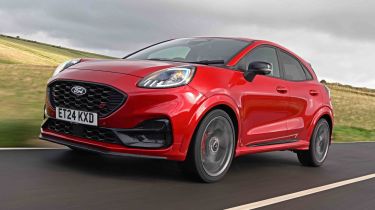Ford Puma ST review
Ford’s racy small SUV was once a performance thriller, but I think it’s lost its pizzazz

Our opinion on the Ford Puma ST
When Ford updated the Puma at the end of 2024, one significant update made to the flagship ST variant wasn’t for the better. That’s because Ford dropped the 1.5-litre EcoBoost petrol engine and manual gearbox from the range, leaving just the lower-powered 1.0-litre version with the Powershift automatic.
This combination simply doesn’t do justice to the ST badge, and while the car’s chassis is as lively and entertaining as it has always been, the lack of punch and slow-witted auto put a big dampener on what the car can deliver. If it were our money, we’d check the used car deals to pick up a pre-facelift 1.5 manual model – it’s still the best small performance SUV going.
| Key specs | |
| Fuel type | Petrol |
| Body style | Five-door small SUV |
| Powertrain | 1.0-litre petrol mild-hybrid auto, front-wheel drive |
| Safety | Five stars Euro NCAP (2022) |
| Warranty | Three years/60,000 miles |
About the Ford Puma ST
The Ford Puma ST is the flagship of the Puma range, so there’s just one model offered and a single engine option since the range was updated at the end of 2024. The Puma ST comes as a five-door, five-seat small SUV powered by the 168bhp 1.0-litre EcoBoost turbo three-cylinder petrol engine with mild-hybrid assistance.
The other main change made at the time of the 2024 facelift was the option of a Handling Pack for around £1,000 extra. This is slightly different from the old ST’s Performance Pack, because rather than adding a limited-slip diff and launch control, it adds KW coilover suspension.
Used - available now

2016 SEAT
Leon
100,958 milesAutomaticDiesel2.0L
Cash £7,099
2022 Ford
Kuga
19,203 milesManualDiesel2.0L
Cash £20,495
2019 Vauxhall
Corsa
22,408 milesAutomaticPetrol1.4L
Cash £11,989
2023 Hyundai
Tucson
37,107 milesManualPetrol1.6L
Cash £16,886Since the middle of 2025, the Puma ST is the only new car on sale that wears Ford’s ST performance car badge. The first ST was the V6-powered Mondeo ST24 from 1996, but with electrification a very important part of Ford’s future, it will be interesting to see if ST can maintain a presence in the brand’s ecosystem.
The fantastic Fiesta ST is long gone, and the Focus ST in hatchback and estate guises are no longer available to order, leaving the Puma ST as the company’s sole ST survivor.
Ford Puma ST prices and latest deals
Prices jumped with the car’s facelift, and the 168bhp 1.0 EcoBoost auto starts from around £34,000, which is around £2,000 more than the old 1.5 EcoBoost manual.
Spec your ideal Ford Puma ST now using our Buy A Car service and choose the best offer from Ford dealers around the UK. You can also lease a Ford Puma ST, or buy a used Ford Puma ST, and we’ll even help you sell your own car with Auto Express Sell My Car.
Engines, performance & drive
| Pros |
|
| Cons |
|
The biggest upheaval for the facelifted Puma ST is under the bonnet, where the selection of powertrains has been slimmed down from two to one.
Gone is the 197bhp 1.5-litre three-cylinder EcoBoost and six-speed manual gearbox from the dazzling Fiesta ST, so that leaves the 168bhp 1.0-litre mild hybrid that was introduced shortly before the Puma’s 2024 facelift. The reason for that powerplant’s introduction was to facilitate the option of a twin-clutch automatic gearbox.
So the Puma ST isn’t as fast as it once was, and the car’s power delivery is also muted by the seven-speed gearbox. When fitted with the manual, the Puma ST offered a level of connection and driving fun that made it genuinely feel like a high-riding Fiesta ST. But in comparison, the slow-witted auto puts a dampener on the whole experience, because it doesn’t have the fast responses to cope with any kind of spirited driving.
Ford’s twin-clutch system isn’t a patch on the superb set-ups offered by the likes of Volkswagen and Hyundai in terms of response or engagement, with its slow reaction times feeling very much at odds with the sporty character that the company’s ST models should display.
| Model | Power | 0-62mph | Top speed |
| 1.0 EcoBoost auto | 168bhp | 7.4 seconds | 130mph |
Performance, 0-60mph acceleration and top speed
With around 30bhp less than the old 1.5-litre model, the ST’s performance has taken a bit of a hit.
A 0-62mph time of 7.4 seconds is 0.7 seconds slower than the old car’s, while 248Nm of torque is 72Nm less than the 1.5-litre engine offered. In addition, the full 168bhp is only available in ‘overboost’ mode – in regular driving, 10bhp is lopped off the engine’s output.
Top speed of the Puma ST is quoted at 130mph, which is 7mph slower than the 1.5 EcoBoost version of the ST.
Town driving, visibility and parking
Just like the standard Puma, the ST is a doddle to drive around town. It’s essentially a high-riding Fiesta, so it has a small footprint but there is a decent view of your surroundings, while the agile chassis and responsive steering help with the cut and thrust of city traffic.
However, even in urban driving, the Puma ST is a bit of a disappointment. Leave the transmission to its own devices, and the electronics struggle to ensure you’re in the right gear. This means the car can feel hesitant when exiting junctions, and when you need a quick response when entering a roundabout, there are times where the gearbox could leave you floundering as it takes its time selecting the right cog.
B-road driving and handling
Increasing your pace on a twisty B-road leaves the gearbox fumbling for gears in most situations. Accelerate out of a tight corner on to a straight, and there’s a hesitation as the gearbox kicks down, which spoils your momentum and flow if you’re looking for some driving fun.
It’s not much better when you take manual control of things. Paddles are fitted behind the steering wheel for shifting up and down, but there’s a delay between selecting the next ratio and the gearbox changing, which further hampers any enjoyment.
This is a real shame, because in all other respects the Puma ST continues to deliver the same playful handling that made it one of our favourite performance SUVs. The steering is fast and direct, while the stiff chassis allows quick changes of direction and produces a level of enjoyment that more expensive performance SUVs struggle to match. The Puma will even lift an inside rear wheel if you’re attacking a particularly sharp corner, helping it maintain its character as a slightly higher-riding alternative to a hot hatchback.
Motorway driving and long-distance comfort
That sporty character also contributes to the other significant downside of the Puma ST. The stiff chassis and firm suspension mean this sporty SUV isn’t the most settled at motorway speeds. There’s a fidget to the ride that can become tiring, while the low-profile tyres amplify this while also contributing to more road noise than in the standard Puma.
"I’m in no doubt that the Puma ST lost some of its appeal with the demise of the 1.5 EcoBoost manual. I find that the 1.0-litre auto is a bit too clunky for this sporty model, so much so that I’d consider the Puma Gen-E instead. I’ve driven both, and while the Gen-E is electric, the automatic transmission is far smoother than the ST’s auto, while it has 166bhp and a 0-62mph time of eight seconds, so it isn’t far behind the 1.0-litre in terms of performance. It’s more comfortable, too, but still handles tidily." - Dean Gibson, senior test editor
MPG, emissions & running costs
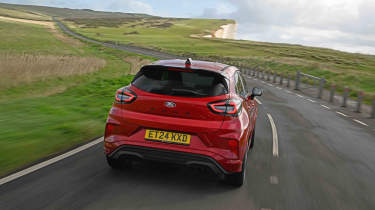
| Pros |
|
| Cons |
|
While the Puma ST has lost some of its sporting spark, the 1.0 EcoBoost and Powershift auto set-up comes with mild-hybrid tech to help boost fuel efficiency. Ford claims the electrified hot SUV will deliver efficiency of up to 47.9mpg and 135g/km of CO2 emissions, compared with 151g/km for the old 1.5 model.
Ford also says that the seven-speed dual-clutch Powershift automatic gearbox has been optimised to work alongside the mild-hybrid system to ensure the engine remains in the optimum range for efficiency when cruising.
| Model | MPG | CO2 | Insurance group |
|---|---|---|---|
| 1.0 EcoBoost auto | 47.9 | 135g/km | 21 |
Insurance groups
A lower power output means the automatic Puma ST sits one group lower than the 1.5 model, but it’s four groups higher than the next petrol Puma, while the electric Gen-E starts from group 18.
Tax
While the Puma ST is the most expensive model in the range, it still comes in below the £40,000 luxury car tax threshold for road tax. If you’re looking at a Puma as a company car, then the ST will be the priciest option due to its CO2 emissions, so again we’d recommend looking at the electric Gen-E for business use.
Depreciation
The Puma ST is the strongest performer in the line-up for resale values at around 55 per cent, the rest of the Puma range is below the 50 per cent mark.
To get an accurate valuation on a specific model check out our free car valuation tool...
Design, interior & technology
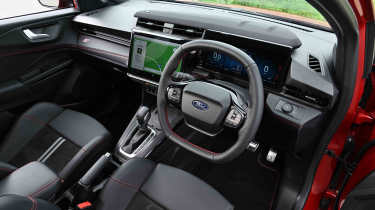
| Pros |
|
| Cons |
|
The flagship Puma ST was subject to the same round of updates as the standard Puma model at the end of 2024. There are minor revisions on the outside, with the most obvious change being to relocate the Ford badge from the leading edge of the bonnet island onto the grille.
The ST continues to wear a subtly chunkier bodykit than the rest of the Puma line-up, with 19-inch wheels, red brake calipers and a rear tailgate spoiler, plus it’s the only version that comes with matrix LED headlamps as standard – they’re an £800 option for the rest of the range.
The options list of the Puma ST is pretty small, with buyers able to add the Handling Pack that includes coilover suspension, a contrasting black finish for the roof, a different 19-inch wheel design and a round steering wheel for around £1,000 extra. There’s also a panoramic sunroof available for the same amount again.
Heated sports seats with six-way manual adjustment are fitted, while synthetic leather and Alcantara trim add to the sporty appearance inside. The sports steering wheel is heated, too, while the multifunction buttons on its spokes include a drive mode selector that switches between Normal, Sport, Eco and Track settings.
Interior and dashboard design
The cabin has been overhauled with Ford’s latest SYNC tech, including a sizable 12-inch touchscreen with the climate controls now integrated within, plus more connectivity and safety kit than ever. There’s a 12.3-inch digital driver’s display as before, while wireless charging and smartphone connectivity is also available.
Materials and build quality
Overall quality is good, although some harder plastics lower down on the dashboard feel a bit cheap in comparison with other models in the class. Everything feels well built, though, so there are no complaints about flimsy materials.
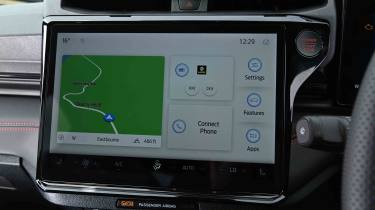
Infotainment, sat-nav and stereo
If you want to take a break from listening to the Puma ST’s rorty three-cylinder soundtrack, Ford has fitted a 10-speaker Bang & Olufsen premium sound system that offers high-quality audio. It’s adjustable via the touchscreen and sounds great.
The screen is responsive, and having the climate controls across the bottom of the display is no hardship, although some of the menu functions can be a little fiddly to use.
"I miss the Recaro seats that were a feature of the original Puma ST, because it now comes with Ford Performance branded buckets. There’s nothing wrong with the seats themselves, but the Recaros offered a connection with Ford’s past RS models and its rallying heritage." - Dean Gibson, senior test editor
Boot space, comfort & practicality
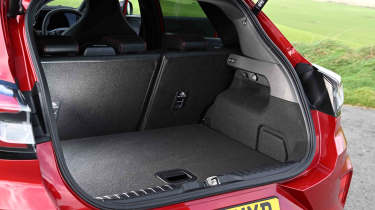
| Pros |
|
| Cons |
|
While revisions have upset the Puma ST’s performance credentials, one feature that remains intact is the car’s practical cabin, which offers more room than you might expect for such a small SUV.
| Dimensions | |
| Length | 4,226mm |
| Width | 1,805mm |
| Height | 1,533mm |
| Number of seats | Five |
| Boot space | 456-1,216 litres |
Dimensions and size
The Puma is a relatively compact small SUV, but clever packaging means space inside is decent. There aren’t many rival performance models to size the ST up against, with the closest option being the larger and more expensive VW T-Roc R, although space is similar between both cars.
Driving position, seats & space in the front
The Puma’s compact dimensions boost its sporty appeal, but they also emphasise the lack of space inside. The snug feel isn’t compromised by a lack of adjustability, though, and it’s easy to get comfortable at the wheel.
Seats & space in the back
Rear-seat space is acceptable for adults, but you’d only really want to sit there for a short period. The bench is narrow, so there’s no centre armrest if just two people are sat there, while shoulder space is tight for three. Small tinted windows add a claustrophobic feel, too.
Boot space
The Puma’s real party trick is the MegaBox in the boot, which will take up to 456 litres in five-seat mode. It’s lined with plastic and features a drain hole, allowing you to store wet items inside and easily pull the plug to drain any excess water afterwards. It’s deep enough that you can fit a set of golf clubs upright in the boot without any problems, too. If you need extra space for longer items, folding the Puma ST’s rear seats down opens up a 1,216-litre cargo bay.
“I like the fact that cars such as the Puma ST exist, because they offer fun driving in a practical package and don’t mean compromises need to be made. It’s not quite as good as it once was, though, and these days a regular Puma is going to be just as much fun, maybe even more so with a manual gearbox.” - Dean Gibson, senior test editor
Safety & reliability
| Pros |
|
| Cons |
|
There’s plenty of safety kit on board the Puma ST, and this includes the Driver Assistance Pack. It’s a £950 option across the rest of the range and features 360-degree cameras, adaptive cruise control with traffic-jam assist, blind-spot detection and lane-change and centring assist.
The Puma was tested by Euro NCAP in 2019 and earned a full five-star crash safety rating. However, a reassessment at the end of 2022 saw the small SUV lose a star due to some poor results for adult occupant safety, causing its score in this category to fall from 94 to 75 per cent.
Ford is slowly climbing the best car manufacturer rankings, according to our data. The brand finished 23rd out of 31 manufacturers, up from its 2024 score of 30th out of 32 brands included. The Puma ranked 47th out of the 50 best cars to own, held back by poor quality and reliability. Owners had positive things to say about the handling, engine noise, and practicality, though.
| Key standard safety features |
|
| Euro NCAP safety ratings |
|
Buying and owning
Best buy: Used Ford Puma ST 1.5 Ecoboost
If you must have a Puma ST, then we’d recommend browsing for a used 1.5 EcoBoost manual example via the Auto Express Buy A Car service. And if you want an automatic, then the standard automatic in ST-Line trim offers nine-tenths of the ST’s ability for less money.
Ford Puma alternatives
The Puma ST is a relatively unique proposition in the small SUV class, because there isn’t another front-wheel-drive performance model like it. The Audi SQ2 and Volkswagen T-Roc R have sporty driving in mind, but they are four-wheel drive and considerably more powerful and expensive.
If it’s performance that you’re after, then the pre-facelift Puma ST is worth seeking out, or even the Fiesta ST on which it’s based, while the Hyundai Kona N is another model that’s rapid, but is based on the previous-generation model.
Frequently Asked Questions
It’s not as good as it once was, and it’s all down to the powertrain. The pre-facelift car is far more entertaining in 1.5 EcoBoost guise, and the 1.0-litre model lacks that car’s pizazz. That’s a shame, because the Puma ST still handles brilliantly, but then the standard car is almost as fun for less money.

